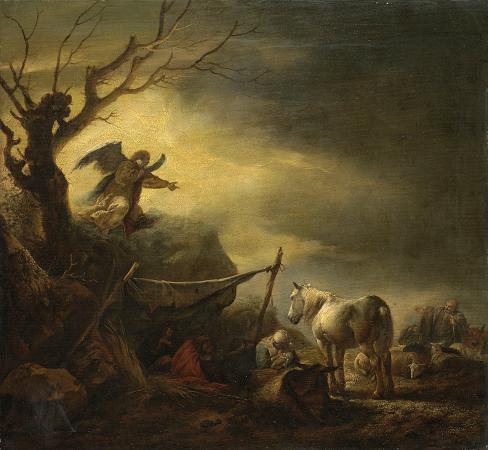Annunciation to Shepherds. The annunciation to the shepherds is an episode in the Nativity of Jesus described in the Bible in Luke 2, in which angels tell a group of shepherds about the birth of Jesus. It is a common subject of Christian art and of Christmas carols. As described in verses 8-20 of the second chapter of the Gospel of Luke, shepherds were tending their flocks out in the countryside near Bethlehem, when they were terrified by the appearance of an angel. The angel explains that he has a message of good news for all people, namely that Today in the town of David a Savior has been born to you; he is the Messiah, the Lord. This will be a sign to you: You will find a baby wrapped in cloths and lying in a manger. After this, a great many more angels appear, praising God with the words Glory to God in the highest heaven, and on earth peace to those on whom his favor rests. Deciding to do as the angel had said, the shepherds travel to Bethlehem, and find Mary and Joseph and the infant Jesus lying in the manger, just as they had been told. The adoration of the shepherds follows. The King James Version of the Bible translates the words of the angels differently from modern versions, using the words Glory to God in the highest, and on earth peace, good will toward men. Most Christmas carols reflect this older translation, with It Came Upon the Midnight Clear, for example, using the words Peace on the earth, good will to men, / From Heaven's all gracious King. The disparity reflects a dispute about the Greek text of the New Testament involving a single letter. The Greek text accepted by most modern scholars today uses the words epi ges eirene en anthropois eudokias, literally on earth peace to men of good will, with the last word being in the genitive case. Most ancient manuscripts of the Greek New Testament have this reading. The original version of the ancient Codex Sinaiticus has this reading, but it has been altered by erasure of the last letter to epi ges eirene en anthropois eudokia, literally on earth to men, with two subjects in the nominative case. Expressed in correct English, this gives the familiar Peace on earth, good will to men of many ancient Christmas carols. Even though some other ancient Greek manuscripts agree with the edited Codex Sinaiticus, most modern scholars and Bible translators accept the reading of the majority of ancient manuscripts, translating as on earth peace to those on whom his favor rests or on earth peace among those with whom he is pleased. The Douay-Rheims Bible, translated from the Latin Vulgate, derives from the same Greek text as the original Codex Sinaiticus, but renders it on earth peace to men of good will. In the New American Bible, this is updated to on earth peace to those on whom his favor rests. It is generally considered significant that this message was given to shepherds, who were located on the lower rungs of the social ladder in first-century Palestine. Contrasting with the more powerful characters mentioned in the Nativity, such as the Emperor Augustus, they seem to reflect Mary's words in the Magnificat: He has brought down rulers from their thrones but has lifted up the humble.The shepherds, taken as Jewish, also combine with the gentile Three Magi, in later tradition thought to be one each from the three continents then known, to represent the first declaration of the Christian message to all the peoples of the world. The phrase peace to men on whom his favor rests has been interpreted both as expressing a restriction to a particular group of people that God has chosen and inclusively, as God displaying favor to the world. Initially depicted only as part of a broader Nativity scene, the annunciation to the shepherds became an independent subject for art in the 9th century, but has remained relatively uncommon as such, except in extended cycles with many scenes. The standard Byzantine depiction, still used in Eastern Orthodox icons to the present, is to show the scene in the background of a Nativity, typically on the right, while the Three Magi approach on the left. This is also very common in the West, though the Magi are very often omitted. For example, the 1485 Adoration of the shepherds scene by Domenico Ghirlandaio includes the annunciation to the shepherds peripherally, in the upper left corner, even though it represents an episode occurring prior to the main scene. Similarly, in the Nativity at Night of Geertgen tot Sint Jans, the annunciation to the shepherds is seen on a hillside through an opening in the stable wall. Scenes showing the shepherds at the side of the crib are a different subject, formally known as the Adoration of the shepherds.
more...









